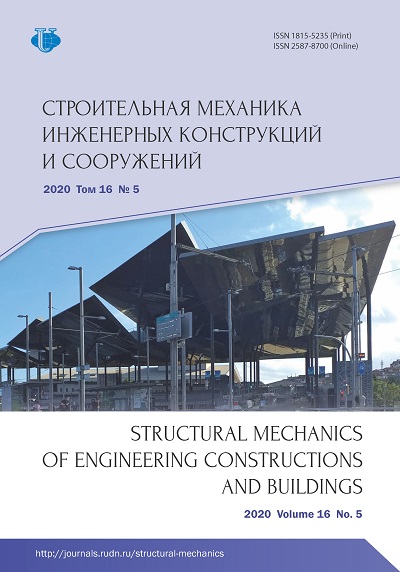Dynamic method for determining critical loads in the PRINS computer program
- Authors: Agapov V.P.1, Markovich A.S.2
-
Affiliations:
- National Research Moscow State University of Civil Engineering
- Peoples’ Friendship University of Russia (RUDN University)
- Issue: Vol 16, No 5 (2020)
- Pages: 380-389
- Section: Numerical methods of structures’ analysis
- URL: https://journals.rudn.ru/structural-mechanics/article/view/24969
- DOI: https://doi.org/10.22363/1815-5235-2020-16-5-380-389
Cite item
Full Text
Abstract
Relevance. Buckling analysis is important in the design of buildings and structures. It is used in various fields of engineering - mechanical engineering, aircraft and shipbuilding, civil engineering, etc. Until the second half of the twentieth century, mainly analytical methods of buckling were applied in practice. With the appearance of computers, numerical methods, in particular, the finite element analysis, began to prevail. Buckling analysis was implemented in programs of finite element analysis, such as NASTRAN, ANSYS, ABAQUS, ADAMS, DIANA, and others. In view of great responsibility, buckling analysis of structure should be carried out using at least two different programs. However, due to the high cost of software products, not all project organizations are able to have a number of programs. An alternative is to develop programs that can complete buckling analysis using several methods. This would increase the reliability and quality of calculation results. The PRINS computer program has opportunity for buckling analysis using two methods - static and dynamic. The aims of the work - to show the theoretical aspects and practical implementation of the dynamic principle of buckling analysis in buildings and structures using finite element method, as well as to give the algorithm implemented in the PRINS program and the results of verification calculations confirming its reliability. Results. The algorithm presented in this article and implemented in the PRINS computer program allows to determine critical loads using a dynamic buckling criterion. On the basis of numerous verification calculations, it was established that the implemented algorithm was effective for determining critical loads in frame, thin-walled and ribbed plate structures. The use of the PRINS computer program enables to use an alternative method for determining critical loads for a wide class of engineering problems in addition to the classical (static) method.
About the authors
Vladimir P. Agapov
National Research Moscow State University of Civil Engineering
Author for correspondence.
Email: markovich-as@rudn.ru
Doctor of Technical Sciences, Professor of the Department of Reinforced Concrete and Stone Structures
26 Yaroslavl Highway, Moscow, 1129337, Russian FederationAlexey S. Markovich
Peoples’ Friendship University of Russia (RUDN University)
Email: markovich-as@rudn.ru
Candidate of Technical Sciences, Associate Professor of the Department of Civil Engineering of the Engineering Academy
6 Miklukho-Maklaya St, Moscow, 117198, Russian FederationReferences
- Euler L. Methodus inveniendi lineas curvas maximi minive proprietate gaudentes. Opera Omnia: Serias 1. 1744;24.
- Timoshenko S., Gere J.M. Theory of Elastic Stability. 2nd ed. McGraw-Hill; 1961.
- Volmir A.S. Ustojchivost' deformiruemyh system [Stability of deformable systems]. Moscow: Nauka Publ.; 1967. (In Russ.)
- Grigolyuk E.I., Kabanov V.V. Ustojchivost' obolochek [Shell stability]. Moscow: Nauka Publ.; 1978. (In Russ.)
- Kornouhov N.V. Prochnost' i ustojchivost' sterzhnevyh system [Strength and stability of frame systems]. Moscow: Strojizdat Publ.; 1949. 376 p. (In Russ.)
- Zienkiewicz O.C., Taylor R.L. The Finite Element for Solid and Structural Mechanics. 6th ed. McGraw-Hill; 2005.
- Bathe K.J., Wilson E.L. Numerical methods in finite element analysis. New Jersey: Prentice-Hall; 2005.
- Crisfield M.A. Non-linear finite element analysis of solids and structures. John Wiley & Sons Ltd.; 1977.
- Oden J.T. Finite elements in nonlinear continua. New York: McGraw-Hill Book Company; 1972.
- Reza Eslami N.M. Buckling and Postbuckling of Beams, Plates, and Shells. Structural Integrity. Vol. 1. Springer International Publishing AG; 2018.
- Gowda R.S., Sunagar P., Nruthya K., Manish S. Dharek, Sreekeshava K.S., Abhishek Kumar Chaurasiya and Priyanka. Analytical and Finite Element Buckling and Post Buckling Analysis of Laminated Plates. International Journal of Civil Engineering and Technology. 2020;11(5):84–92.
- Iwasa T., Nishizawa Sh., Sakai M. Buckling severity measurement of axially compressed cylindrical structures with periodic buckling pattern. Engineering Structures. 2020;213:110568. doi: 10.1016/j.engstruct.2020.110568.
- Li D.M., Featherston C.A., Wu Z. An element-free study of variable stiffness composite plates with cutouts for enhanced buckling and post-buckling performance. Computer Methods in Applied Mechanics and Engineering. 2020;371:113314. https://doi.org/10.1016/j.cma.2020.113314
- Buoso D., Parin E. The buckling eigenvalue problem in the annulus. Communications in Contemporary Mathematics. 2020. https://doi.org/10.1142/S0219199720500443
- Heo J., Yang Z., Xia W., Oterkus S., Oterkus E. Buckling analysis of cracked plates using peridynamics. Ocean Engineering. 2020;214:107817. doi: 10.1016/j.oceaneng.2020.107817.
- MSC NASTRAN 2016. Nonlinear User’s Guide SOL 400. MSC Software; 2016.
- ANSYS Theory Reference. Release 5.6. Canonsburg, PA: ANSYS Inc.; 1999.
- ABAQUS 6.12. Theoretical manual. DS Simulia; 2012.
- ADINA Theory and Modeling Guide. ADINA R&D, Inc.; 2005.
- DIANA FEA User’s Manual. Release 10. DIANA FEA BV; 2017.
- Agapov V.P. Metod konechnyh elementov v statike, dinamike i ustojchivosti konstrukcij [Finite element method in statics, dynamics and stability of structures]. Moscow: ASV Publ., 2005. (In Russ.)
- Agapov V.P. Buckling Analysis of the Structures by Single Imposed Constraint Method. International Journal of Applied Engineering Research. 2017;12(16):5990–5994.
















